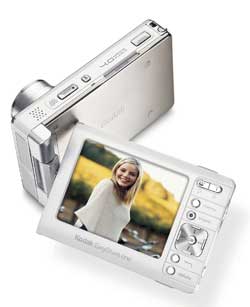

 It's the camera's features that really affect its price, so which ones
should you focus on?
It's the camera's features that really affect its price, so which ones
should you focus on?Shopping for a digital camera can be bewildering. Prices range from nothing
at all for the basic cameras built in to new mobile phones to several thousand
pounds for complex digital SLRs. The good news is that digital cameras have never
been cheaper, and you now can pick up a perfectly capable budget snapper for £150,
or even less. But the technology is still evolving at a fearsome rate, and any
camera you buy today is likely to be superseded by a smaller, more powerful model
in a matter of months.
The two most important features of any digital camera are its resolution and its
lens. Resolution, measured in megapixels, determines how much detail the camera
can capture and thus how large you can print its images. As a rule of thumb, three
megapixel (3MP) images will look fine at postcard (6x4-inch) sizes, while for
A4 prints, you should aim for at least a 5MP camera. Three megapixel cameras start
from under £100, 5MP cameras range from £200 to £400, and you
can now find 7MP models from £300. Although these advanced cameras can give
smoother, more realistic photos, they need larger memory cards and you may be
sacrificing other features for resolution you simply don’t need.
But it doesn’t matter how many megapixels your camera can capture if it’s
looking at the world through a low quality lens. Only the cheapest and smallest
cameras come without an optical zoom lens these days, and a digital zoom function
is really no substitute. A 3x zoom lens is flexible enough for most landscapes
and portraits, but if you’re into shooting wildlife or sports, check out
the ultrazooms. These cameras, starting at around £250, offer large zoom
ranges of anything from 8x to 12x, bringing distant objects much closer. The best
of these have image stabilisers to reduce the blurring caused by camera shake
at telephoto focal lengths.
Once you’ve got an idea of the resolution and lens you want, it’s
time to consider other features. A large LCD screen (2-inches or more) will help
with framing and make showing off your images easier, but try it outside as some
can be hard to see in bright light. Pre-programmed scene modes such as portrait,
night and sports will make it easier to shoot in specific situations, but in the
long run you’ll get more out of manual features like aperture priority,
spot metering and a choice of focus options. Don’t worry if these seem complex
at first, as all cameras have an auto-everything mode for instant snapping.
Digital cameras are also getting better at taking short video clips, although
they’re still no match for tape-based camcorders. Movies shot at VGA (640x480-pixel)
quality and 30 frames per second will be good enough to watch on TV, but avoid
cameras that can’t capture audio alongside. Other high speed features like
burst modes to snatch a series of frames one after another, short shutter delays
and fast start-up times are also worth spending a little more on.
Always handle a camera before you buy it. Check that you’re happy with its
weight and size, and play with the controls and menus. A metal body will be tougher
than a plastic housing, and there are even some stylish weather- and water-proof
cameras for the ultimate in go-anywhere shooting (from £200). Don’t
worry too much about what power source or memory system a camera uses. Rechargeable
batteries are cheap (from £5) and you should budget around £50 for
a large 512Mb memory card that can store hundreds of images.
If you’re serious about photography, you might want to consider a digital
SLR (from £600 to £3000). These have high quality optical viewfinders,
dozens of manual features and generally offer much better image quality. Because
they use interchangeable lenses, they’re extremely flexible, and most can
also use lenses and flash units from the same manufacturer’s range of film
SLRs. But you won’t get a movie mode and you can’t use the LCD screen
for framing, so they’re not ideal for novices.
Whatever camera you choose, shop around the best deals. Internet retailers may
have the lowest prices, but you can’t beat the customer service from a dedicated
photo retailer. Last season’s cameras can represent real bargains. They’re
often a little heavier or slower than the current models, but the price savings
can be considerable.